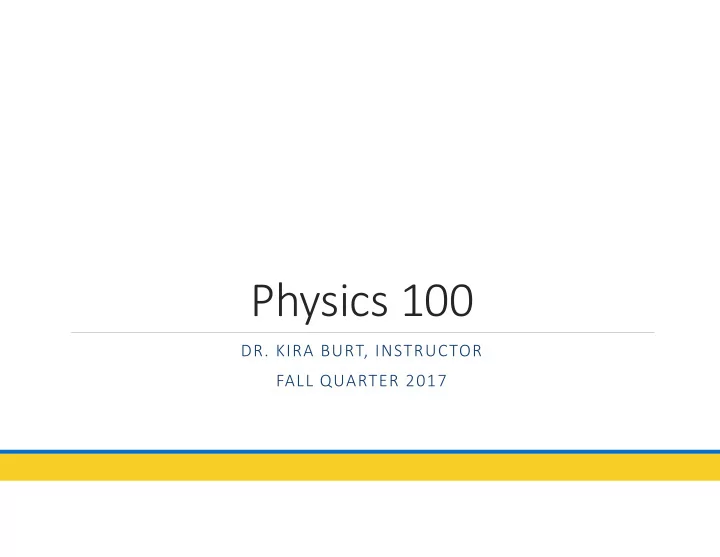

Physics 100 DR. KIRA BURT, INSTRUCTOR FALL QUARTER 2017
Welcome! In Physics 100 we will: ◦ Learn about the foundations of science and the scientific method ◦ Apply the scientific method in laboratory contexts by making observations, recording data and measurements, and explaining results ◦ Understand physics concepts and their applicability to other fields of study and work ◦ Communicate results and analysis clearly in both written and verbal form ◦ Learn about major physics discoveries and their impact on history and progress
Welcome! Instructor: ◦ Dr. Kira Burt – email kira.burt@sfcc.Spokane.edu, phone (509) 533‐3668 ◦ B.S Physics, Eastern Washington University (with transfer from SFCC!) ◦ Ph.D Nuclear and Particle Physics, University of California, Riverside Office hours: ◦ 12‐5 PM Tuesdays ◦ 10:30‐12:30 Wednesdays ◦ By appointment Fridays
Textbook: ◦ Conceptual Physics, 12 th ed., Paul G. Hewitt I do not have an attendance policy as such – I will regularly hand out in‐class work, so if you miss class you miss those points, and they can’t be made up. Point distributions are shown on the syllabus. Homework will be assigned through MasteringPhysics. You can set up an account through Pearson. Late work is not accepted. If you contact me before missing a class, I may be able to work with you, but I can only do this once per student per quarter. See the syllabus for details.
How to succeed at physics 1. Be Albert Einstein 2. If you can’t do #1, try these: 1. Break down a problem into its component parts. Use KEY WORDS (lift, drop, push, pull) to figure out a strategy 2. Verbalize. Describe the problem to yourself or your classmates in your own words. Do this when you get stuck. Try drawing the problem in picture form as well. 3. Ask questions. If you’ve broken down a problem and talked it out and are still struggling, ask about what you don’t understand. 4. PRACTICE. Working problems is the only way to get better at working problems!
Chapter 1: About Science THE SCIENTIFIC METHOD
What IS science? Science is… ◦ Our existing knowledge of nature and the processes occurring within it, and the classification and ordering of that knowledge ◦ The active PURSUIT of new knowledge via observation, measurement, experiment, and analysis
What is a scientist? A scientist: ◦ Observes patterns in nature ◦ Makes experiments or further observations to explain these patterns ◦ Uses these explanations to make predictions, invent and improve technology, or teach others
www.xkcd.com/242/
The scientific method A method used since ~16 th century to gather, analyze, and extrapolate from data 1. Observation – notice a pattern that is currently not explained, or not well explained 2. Hypothesis – make an educated, testable guess about the cause of the pattern 3. Prediction – use the hypothesis to make predictions about the behavior of the system 4. Experiment or further observation – tests the predictions 5. Reject or accept hypothesis if rejected, go to step 2, refine your hypothesis, and try again 6. If hypothesis is accepted, continue to gather data to refine predictions 7. Synthesize hypotheses and facts to form a theory
The scientific method Observe pattern/problem Make/refine hypothesis Make prediction Test prediction: Experiment, observe Collect more data, form theory Accept hypothesis
What does “testable” mean? Which of these is a scientific hypothesis: 1. The Moon is closer to the Earth than the Sun. 2. The Sun affects Earth’s tides. 3. Undetectable particles are all around us, all the time. 4. Physics is the most important of all the sciences.
What does “testable” mean? Which of these is a scientific hypothesis: 1. The Moon is closer to the Earth than the Sun. 2. The Sun affects Earth’s tides. 3. Undetectable particles are all around us, all the time. 4. Physics is the most important of all the sciences. In order for a hypothesis to be testable, we must be able to make observations that can prove it wrong. There must be a test for wrongness!
The scientific method: Spontaneous Generation 1. Observation – Rotting meat is often covered with flies (gross) 2. Hypothesis – Aristotle says that maggots, and therefore flies, are spontaneously generated by the rotting meat itself ◦ Is this a testable hypothesis? How? ◦ Yes! Francesco Redi tested spontaneous generation in 1668. ◦ How would you test this hypothesis? Can you think of a prediction?
The scientific method: Spontaneous Generation 3. Prediction – Redi decided that if spontaneous generation is true, then maggots would spawn on rotting meat that flies had never touched 4. Experimen t – Redi set up a system to check maggot status vs. fly access 5. Result – No maggots appeared when flies could not lay eggs or land on the meat. Aristotle’s hypothesis of spontaneous https://coppertellerium.wordpress.com/2014/08/13/spontaneous‐generation‐theory/ generation is REJECTED
The scientific method: Spontaneous Generation 2. Back to hypothesis – maybe we can refine the method! Louis Pasteur tested spontaneous generation on microorganisms 3 . Prediction – Microorganisms are spontaneously generated by a nutrient broth 4. Experiment – restrict external access to the broth by microorganisms using a swan‐necked flask 5. Result – Microorganisms do not generate in the sealed vessel. Spontaneous generation is https://coppertellerium.wordpress.com/2014/08/13/spontaneous‐generation‐theory/ REJECTED
The scientific method Why do we use the scientific method? ◦ Provides falsifiable , verifiable results ◦ Other scientists can replicate methods and analysis to test the outcome of a hypothesis – above all, a hypothesis must be testable. You can always, always check results ◦ A well‐tested scientific theory is a powerful predictive and analytical tool! Germ theory of disease Theory of relativity
Next time – peer review and measurements
Recommend
More recommend